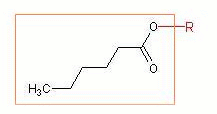|
Groups are encoded by using the
structural unit annotation format, as shown for
terminal groups and
multivalent groups. To include
hints or details about the group environment, the
group environment annotation
format is used. The following example demonstrates encoding of a group,
the hexanoyloxo group, in which the neighborhood of the O-atom with an
open single bond is specified as an alkyl group:
|

|
|
CCCCCC(=O)O{-R}
|
|
Hexanoyloxo group of alkyl n-hexanoates
|
|
|
The neighborhood is not considered to be part of the encoded group.
Otherwise the annotation marker {+R}
should be used to encode the corresponding
set of molecules, alkyl n-hexanoate molecules
in this case.
|
|
By default, the annotation {-R} refers to
both branched and linear alkyl groups. To exclude branched alkyl groups,
the entry bra=0 needs to be added:
|
|
CCCCCC(=O)O{-Rbra=0}
|
|
Hexanoyloxo group of n-alkyl hexanoates
|
|
|
Annotations marked by {-X} encode groups attached
to an halogene atom, such as the hexanoyl group in n-hexanoyl halides:
|
|
CCCCCC{-X}=O
|
|
Hexanoyl group of n-hexanoyl halides
|
|
|
Annotations marked by {-Y} encode groups attached
to any other group. In the following example the other group is an oxo group,
O{-}{-}:
|
|
CCCCCC{-Yc=O{-}{-}}=O
|
|
Hexanoyl group attached to an oxo group
|
|
|
Formally, the open bond connects to the first matching open bond of
the group notation inside the annotation, reading from left to right.
|
|
Certainly, the group focus can be flipped:
|
|
O{-}{-Yc=C{-}(=O)CCCCC}}
|
|
Oxo group attached to hexanoyl group
|
|
|
As shown, the group environment annotation format permits group encoding that
precisely describes what is part of a given group and what belongs to the
group environment. Such distinction is critical, for example, in the development
and application of group contribition methods (GCMs), in which particular
contributions often depend on neighborhood specification to account for
intramolecular interactions.
|
_
__
__
 __
__
__
Share on Tumblr
___

|
 __
__


